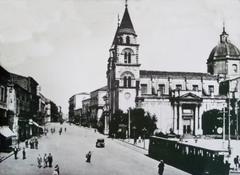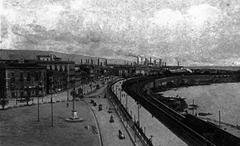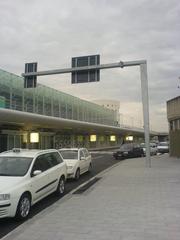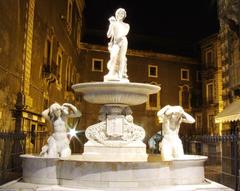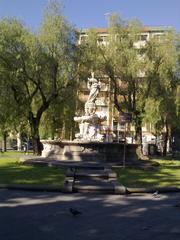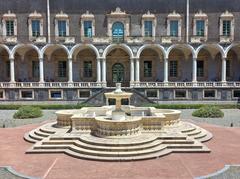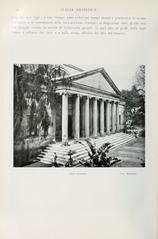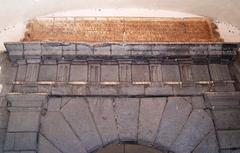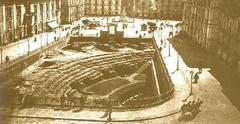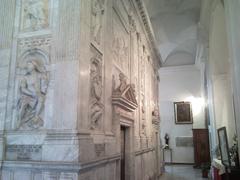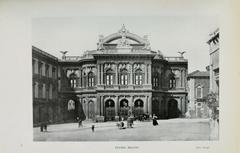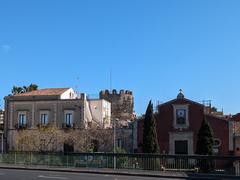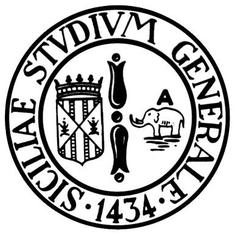Catania Cathedral Visiting Hours, Tickets, and Historical Sites Guide
Date: 14/06/2025
Introduction: The Significance of Catania Cathedral
Catania Cathedral, officially the Metropolitan Cathedral of Saint Agatha (Cattedrale metropolitana di Sant’Agata), stands as a testament to Sicily’s layered history and vibrant culture. Set in the heart of Catania on Piazza del Duomo, this magnificent structure reflects centuries of resilience, religious devotion, and architectural innovation. Built atop ancient Roman ruins after the Norman conquest in the late 11th century, the cathedral has survived devastating earthquakes, fires, and multiple reconstructions—most notably its dramatic Baroque transformation following the catastrophic 1693 earthquake under architect Giovanni Battista Vaccarini.
The cathedral’s Baroque façade, constructed from a striking blend of black volcanic lava stone and white limestone, embodies Catania’s unique identity as “the black city.” Inside, visitors can find relics of Saint Agatha (the city’s patron saint), the tomb of renowned composer Vincenzo Bellini, and a rich array of chapels, frescoes, and archaeological remnants. Today, Catania Cathedral is not just a religious sanctuary but a lively cultural hub, hosting festivals, concerts, and guided tours.
This guide offers comprehensive information for visitors: from historical context and architectural highlights to practical details on visiting hours, tickets, accessibility, and recommended nearby attractions. Whether you’re a history buff, architecture enthusiast, or simply exploring Sicily, Catania Cathedral is an essential experience (Wikipedia; Italia.it; Salt in Our Hair; Budget Your Trip).
Table of Contents
- Introduction
- Historical Overview
- Architectural Highlights
- Cultural and Religious Significance
- Visiting Information
- Frequently Asked Questions (FAQ)
- Visuals and Interactive Media
- Conclusion
- Sources
Historical Overview
Origins and Early Construction
The roots of Catania Cathedral trace back to the Norman conquest of Sicily, with construction beginning in 1078 and concluding in 1093 under Roger I. The cathedral was erected atop the ruins of the ancient Roman Achillean Baths, fragments of which are still visible in the crypt (Eternal Arrival; Italia.it). The initial structure was a fortified church, marked by Norman robust stonework, a solid transept, semicircular apses, and Roman masonry incorporated into the crypt (Palazzo San Giorgio).
Medieval Transformations
Natural disasters and warfare marked the cathedral’s medieval era. The 1169 earthquake collapsed the roof during a religious ceremony, and a fire in 1194 caused further damage during Henry VI’s conquest. Despite these tragedies, the cathedral remained central in Catania’s spiritual and civic life, undergoing periodic repairs and additions, including Swabian architectural elements (The Design Gesture; Italia.it).
The 1693 Earthquake and Baroque Rebirth
The 1693 earthquake was a turning point, nearly destroying the cathedral and much of Catania. Only the apse and some façade sections survived. The city’s subsequent reconstruction led to a Baroque renaissance, with Giovanni Battista Vaccarini designing the new façade between 1734 and 1761. The design is notable for its Corinthian columns, granite pillars, and striking color contrasts between black lava stone and white limestone (The Design Gesture; E-A-A). Later enhancements in the 19th century included a new bell tower and courtyard layout.
Architectural Highlights
The cathedral is a blend of Norman, Gothic, Renaissance, and Baroque influences. Key features include:
- Baroque Façade: Completed by Vaccarini, with three tiers of Corinthian columns, granite pillars, and detailed statues—including a central sculpture of Saint Agatha (Salt in Our Hair).
- Volcanic Stonework: Black lava stone from Mount Etna gives the cathedral and city their unique “black city” character.
- Bell Tower and Dome: The 70-meter bell tower and Baroque dome, visible across the city, are later additions that emphasize the cathedral’s grandeur.
- Interior Elements: The Latin cross layout, polychrome marble flooring, and repurposed ancient columns create an atmosphere of historical continuity. The richly decorated chapels, neoclassical dome, and monumental organ add to the interior’s splendor.
- Crypt and Roman Ruins: Beneath the cathedral, the crypt preserves remnants of the original Norman church and Roman baths.
- Integration with Piazza del Duomo: The cathedral anchors the main square, flanked by Baroque buildings and the iconic Fontana dell’Elefante (Savoring Italy).
Cultural and Religious Significance
Catania Cathedral is dedicated to Saint Agatha, a 3rd-century Christian martyr and the city’s patroness. Her relics are preserved in a silver casket, central to the annual Festival of Saint Agatha in February, which brings thousands of pilgrims to Catania (Nomads Travel Guide). The cathedral also houses the tomb of composer Vincenzo Bellini and several Aragonese royal tombs.
The cathedral is the focal point of religious, civic, and cultural life in Catania, hosting festivals, concerts, and major liturgical celebrations throughout the year.
Visiting Information
Hours, Tickets, and Accessibility
- Opening Hours: Catania Cathedral is typically open from 8:00 AM to 7:00 PM daily, with slight variations depending on religious services or events (Cattedrale di Sant’Agata). Always check the official website for the latest schedule.
- Entry and Tickets: Entry to the main cathedral is free. Access to specific areas such as the crypt, dome, or bell tower usually requires a ticket (approx. €5). Tickets are available on site or via authorized tour operators.
- Accessibility: The main entrance is wheelchair accessible. Assistance is available upon request, though access to the dome and crypt may be limited for those with mobility issues.
Guided Tours and Special Events
- Guided Tours: Guided tours in multiple languages provide deeper insight into the cathedral’s history and architecture. Booking ahead is recommended, especially during peak periods.
- Special Events: The cathedral hosts the renowned Festival of Saint Agatha, daily Mass, and occasional concerts. Access to certain areas may be restricted during major events—consult the cathedral’s event calendar.
Travel Tips and Nearby Attractions
- Getting There: Located in Piazza del Duomo, the cathedral is easily reached on foot from most of Catania’s historic center. Catania Centrale train station is a 15-minute walk away (mapturners.com).
- Dress Code: Modest attire covering shoulders and knees is recommended.
- Nearby Attractions:
- Fontana dell’Elefante: Catania’s lava stone elephant fountain, a city symbol.
- Palazzo degli Elefanti: The city hall next to the cathedral.
- Via dei Crociferi: Baroque church-lined street nearby.
- Chiesa della Badia di Sant’Agata: Offers panoramic city views from its dome.
- La Pescheria Market: Traditional fish market a short stroll away (travellingjezebel.com; thecrazytourist.com).
Frequently Asked Questions (FAQ)
Q: What are the opening hours of Catania Cathedral?
A: Generally 8:00 AM to 7:00 PM daily, but check the official website for current hours.
Q: Is entry to the cathedral free?
A: Yes, entry to the main area is free. Some sections (crypt, dome, bell tower) require a ticket.
Q: Are guided tours available?
A: Yes, in multiple languages. Booking ahead is recommended.
Q: Is the cathedral accessible to people with disabilities?
A: The main entrance is wheelchair accessible. Some areas, such as the dome and crypt, may not be.
Q: When is the best time to visit?
A: Early mornings or late afternoons offer fewer crowds and the best light for photography.
Visuals and Interactive Media
Interactive Map of Piazza del Duomo and Catania Cathedral
Conclusion
Catania Cathedral is a living monument to Sicily’s resilience, artistry, and faith. From its Norman origins atop Roman ruins to its Baroque transformation, the cathedral encapsulates Catania’s unique spirit and history. Visitors are invited to explore its architectural wonders, venerate its sacred relics, and immerse themselves in the city’s vibrant cultural life. Plan ahead by checking current visiting hours, ticket requirements, and special events on official platforms. Enhance your visit with guided audio tours or by exploring related historic sites nearby.
For the latest updates, download the Audiala app, follow us on social media, and explore related articles to enrich your trip to this iconic Sicilian landmark.
